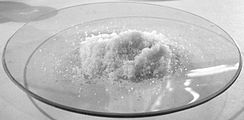Ammonium carbonate
 |
|
 |
|
 |
|
| Names | |
|---|---|
|
IUPAC name
Ammonium carbonate
|
|
Other names
|
|
| Identifiers | |
|
506-87-6 |
|
| 3D model (Jmol) | Interactive image |
| ChemSpider |
10048 |
| ECHA InfoCard | 100.007.326 |
| E number | E503 (acidity regulators, ...) |
| 4509 | |
| UNII |
PDP691CN28 |
|
|
|
|
| Properties | |
| (NH4)2CO3 | |
| Molar mass | 96.09 g/mol |
| Appearance | White powder |
| Density | 1.50 g/cm3 |
| Melting point | 58 °C (136 °F; 331 K) |
| Boiling point | Decomposes |
| Soluble, decomposes in hot water | |
| -42.50·10−6 cm3/mol | |
| Hazards | |
| Main hazards | |
| Safety data sheet | External MSDS |
| Related compounds | |
|
Other anions
|
Ammonium bicarbonate |
|
Other cations
|
Sodium carbonate Potassium carbonate |
|
Except where otherwise noted, data are given for materials in their standard state (at 25 °C [77 °F], 100 kPa).
|
|
|
|
|
| Infobox references | |
Ammonium carbonate is a salt with the chemical formula (NH4)2CO3. Since it readily degrades to gaseous ammonia and carbon dioxide upon heating, it is used as a leavening agent and also as smelling salt. It is also known as baker's ammonia and was a predecessor to the more modern leavening agents baking soda and baking powder. It is a component of what was formerly known as sal volatile and salt of hartshorn.
Ammonium carbonate is produced by combining carbon dioxide and aqueous ammonia. About 7000 tons/year were produced as of 1997.
Ammonium carbonate slowly decomposes at standard temperature and pressure through two pathways. Thus any initially pure sample of ammonium carbonate will soon become a mixture including various byproducts.
Ammonium carbonate can spontaneously decompose into ammonium bicarbonate and ammonia:
Ammonium carbonate may be used as a leavening agent in traditional recipes, particularly those from northern Europe and Scandinavia (e.g. Speculoos, Tunnbröd or Lebkuchen). It also serves as an acidity regulator and has the E number E503. It can be replaced with baking powder, but this may affect both the taste and texture of the finished product.
Its use as a leavening agent, with associated controversy, goes back centuries:
In the third kind of bread, a vesicular appearance is given to it by the addition to the dough of some ammoniacal salt, (usually the sub-carbonate,) which becomes wholly converted into a gaseous substance during the process of baking, causing the dough to swell out into little air vessels, which finally bursting, allow the gas to escape, and leave the bread exceedingly porous. Mr. Accum, in his Treatise on Culinary Poisons, has stigmatized this process as "fraudulent," but, in our opinion, most unjustly. The bakers would never adopt it but from necessity: when good yeast cannot be procured, it forms an admirable and perfectly harmless substitute; costing the baker more, it diminishes his profit, while the consumer is benefited by the bread retaining the solid matter, which by the process of fermentation is dissipated in the form of alcohol and carbonic acid gas.
...
Wikipedia
